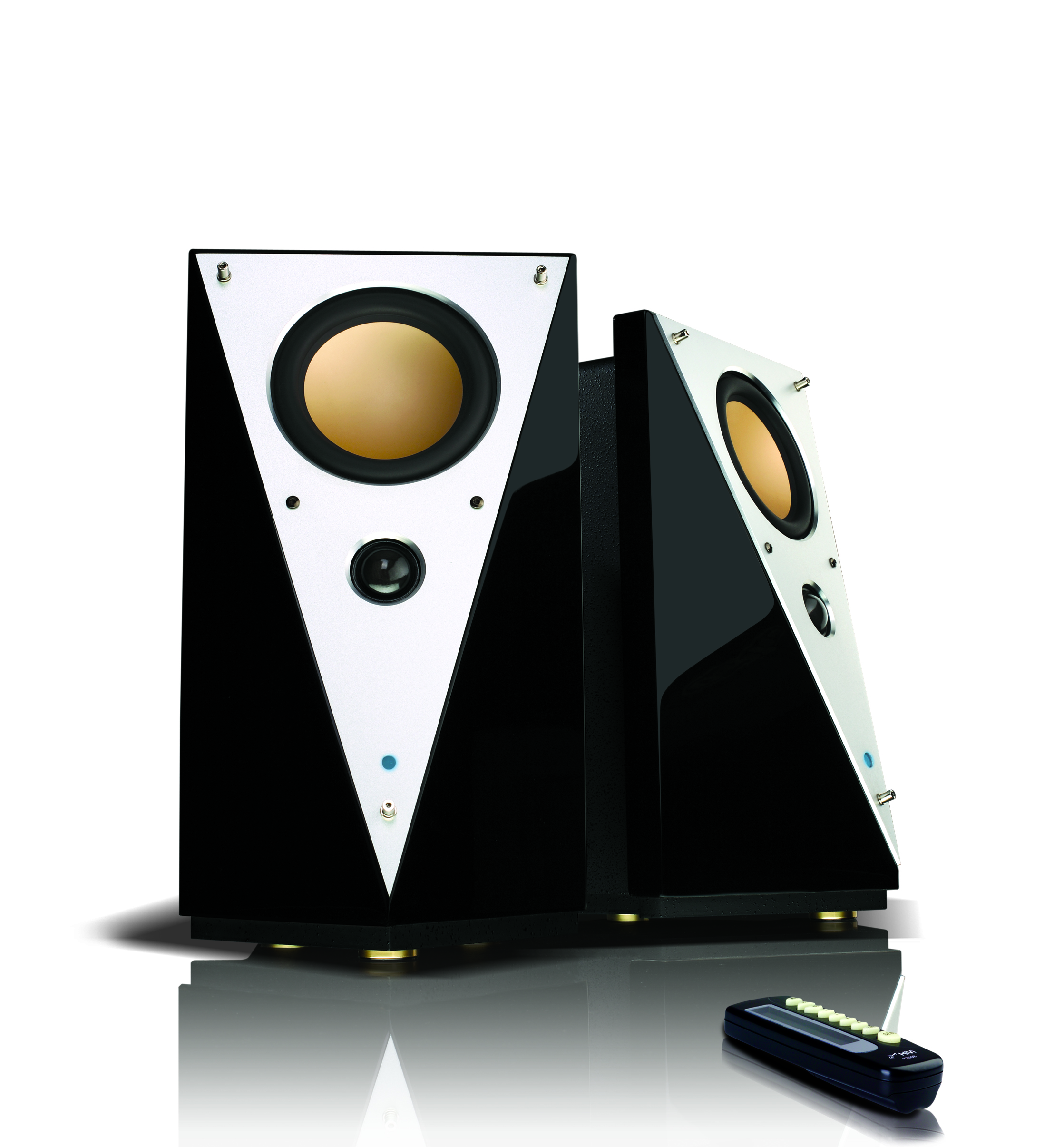
Read our review of the Swans T200B Professional Multimedia Monitor system – are these the audiophile’s answer to good computer speakers?

When you buy a desktop computer you will receive with it for virtually no extra money a stereo loudspeaker system. These days having no sound on a computer simply isn’t an option.
But those free loudspeakers are usually things of horror. Generally they have small drivers loosely mounted in thin plastic enclosures. They buzz even when they’re supposed to be quiet, and make no pretence of accurate sound reproduction.
Now if all you want computer speakers for is the notification ding from email being received, they’ll do. But if you want to do something more, say, listen to music, you must change them.
At this point it’s worth pausing and considering an important difference between computer speakers and the computers to which they’re attached. A computer and nearly all its attached bits will be obsolete within a year or two of purchase, but its replacement will still use standard audio outputs, and your loudspeakers will work fine with it. They’ll still be working on its fifth generation replacement in ten years.
So, unlike your computer, consider your computer loudspeakers to be a long term purchase.
Viewed in that light, then – and in the light of the quality they provide – the $799 Swans computer loudspeakers are very good value.
Drivers
As multimedia loudspeakers go the Swans T200B speakers are big. Not too big for a regular desk, but you may need to shuffle some papers aside to accommodate their 217mm wide by 270mm deep footprint. They are even deeper than that (383mm) due to protruding rear panel controls, connections and the heatsinks for the built in amplifiers. They stand a fairly imposing 272mm tall.
Nor should you, even if it were physically possible, push them hard up against a wall because they are bass reflex loudspeakers. That is, they have tuned ports to allow resonances in the enclosed space to supplement the bass. Each enclosure has two of these ports, both at the bottom rear of the enclosure.
Provided with the speakers are four foam plugs which you can use to tune the effect of these ports. In general, these are best avoided unless you are extremely confident in your ability to assess bass performance.
I won’t try to fully explain the triangular front panel of these speakers. Just look at the pictures on this page. There are not timidly styled, and you will need to judge for yourself when they would enhance the attractiveness of your desk. Their finish is excellent, from the black piano lacquer panels immediately around the baffle, through to the solidity of construction (they weigh 8 kilograms each).
These are two-way loudspeakers with a 127mm bass/midrange and a 28mm dome tweeter in each enclosure. The triangular baffle – with the pointy end towards the bottom and holding the tweeter – is angled up slightly so that when sitting on desk on either side of a computer monitor both drivers are ‘firing’ directly up towards the computer user.
They have built-in amplifiers of course, each rated at 40 watts continuous. Each has a regular RCA socket for input, plus an XLR balanced socket. This will be unused by most people, but if you are using these speakers with your computer operating as a high-end digital work station, your equipment may well support this higher quality connection.
These inputs are at the back, along with the two-pin power socket for each speaker and a hard power switch. There is also a volume knob at the back of each. This may seem inconvenient, but you don’t actually need to use this because the system comes with an infrared remote control.
Listening
The remote is a little tricky. It has buttons for master volume up and down, and can also trim the balance by means of left volume up and down, and right volume up and down. There’s also a mute button.
Now this can be an impractical arrangement. Imagine, you are sitting within arms reach of both speakers, so from your point of view they are separated by quite a wide angle. It’s all too easy to make an adjustment and have it affect only one of the two speakers. They clearly respond to a remote command by momentarily flashing a blue LED which sits under the grille to red.
That’s where another key on the remote comes in. Called ‘Send’, this simply re-emits the current settings. It took almost no time for me to get used to changing the volume, with certainty, by pressing the master volume key with the remote pointed at one, then shifting to the other and pressing ‘Send’.
Obviously speakers such as this are going to be a joy to the ear in comparison to the cheap computer speakers I mentioned above. But be aware I don’t normally use such horrible speakers on my own system. My ears are conditioned by the high quality compact stereo loudspeakers, driven and EQ’d by a 90 watt per channel home theatre receiver and supplemented (bass management performed by the receiver) by a 50 watt, 200mm subwoofer.
Even so, to my ears these Swans speakers were a delight in sound quality. The first thing I noticed was the exactness of the stereo imaging. Every element of a stereo spread was precisely defined. In part this is likely due to the close matching between stereo pairs. Swans provides each pair with individually measured frequency response graphs. The review pair were very closely matched both on paper and to the ear. The measured responses came to a range from 60 hertz (on one, 62 hertz on the other) to 20,000 hertz +/- 3dB.
That tonal balance was clearly evident. Both male and female vocals were very natural sounding, and stood at their proper level in the sound mix. They were also capable of providing plenty of clean punch. No, I should say that they were able to verge on prodigious levels of clean punch. I put a digital SPL metre on ‘Fast’ and ‘Peak Hold’ and found that with the metered level averaging around 100dB and peaking at 105dB, the sound remained clean and balanced. Remember, I was sitting just 900mm from the speakers. They are after all intended for this close up use.
Advancing the volume a few more decibels reduced clarity and introduced a level of harshness into the sound that should be avoided. I suspect that the amplifiers were running into their limits.
I performed a quick frequency response test in situ – a desk top with a large flat area immediately in front of the loudspeakers is far from the ideal performance space. The results were extremely impressive. As with the frequency response graphs packed with the speakers, the bass roll-off started at about 100 hertz. It was a bit steeper on my desktop, but usable bass was available down to 70 hertz. The overall balance suggested by my measurement showed a slight bass forwardness, and with the higher treble down perhaps three decibels from the midrange. Since higher frequencies tend to be differentially filtered by their passage through the air, this meant that the subjective sound balance of the speakers was very similar to high end high fidelity speakers listened to at a more normal three or four metre range.
There was one noticable lack, though: deep bass. The fundamental thud of a kick drum was simply not there, nor the deeper bass guitar notes nor synth underpinning used on some tracks.
So let me warn you. I have several CDs in my collection where the sound engineer obviously used high quality but small monitors in mastering the sound. The problem was that this left deep bass noise inaudible to him … but all too audible on a modern sound system.
These speakers are quite accurate enough for digital audio purposes, let alone hifi, so long as you add a subwoofer.
Conclusion
Do remember that while $799 is a pretty steep price for ‘computer speakers’, the Swans T200B active loudspeakers are units that you will keep on using over the course of several computer changeovers. Give them a listen.
Product: T200B multimedia monitors
Manufacturer: Swans
Distributor: Oceanic Distribution
Contact: 1300 556 303, www.oceanicdistribution.com

